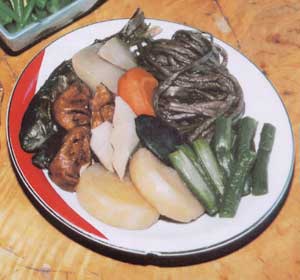
Certification year
1996
Type of certification
traditional Cousine
Main area
Nishiwaga
Introduction of cooking
It has been passed down as an essential item for gatherings of festivals and events since ancient times, regardless of events or events. He boldly cooks the rich wild vegetables of Nishiwaga and brings out the deliciousness.
material
Mainspring, carrots, soy sauce, udon or bowl, fried tofu, salt, bamboo shoots, kelp, mirin, river fish or fish, rice bran, ganmodoki, seaweed kelp, buna maiko, konnyaku
How to make
1. Peel the dried mainspring in hot water several times, and restore sufficiently. The salted pot is soaked in water and salted well. Keep the kelp back in the water.
2. Cut vegetables such as carrots into large pieces.
3. Cut to make it easy to taste konjac.
4. Take the soup stock with kelp.
5. Put the ingredients in a large pot, add the soup to the extent you want to cook and simmer. Add seasonings, simmer and slowly simmer over low heat.
Cooking point
1. Firmly return Shiosan.
2. Cut the material into large pieces and align the size. Konnyaku etc. devise how to cut, such as providing a wave so that the taste is easy to stain.
3. If you put dried river fish, a soup comes out.

"Sansai cuisine" of Atsuko Sasaki
Contact: Nishiwaka-cho Sawauchi Maego first ground 19
Telephone 0197-85-2258
Explanation A regional cuisine where you can enjoy the taste of the wild vegetables of the Nishiwaga region entirely. I will teach experience.
